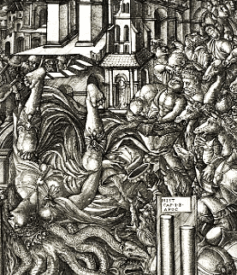
Trump has pulled the rug from under NATO’s reason for existing. For most of the alliance’s history, Europeans were more than willing to believe in a US security guarantee in the semblance of “extended deterrence”—the somewhat ambiguous appendage of America’s strategic nuclear forces to European defenses. All the while, though, analysts in Washington were exploring concepts for employing “tactical” nuclear weapons in a way they hoped would confine an actual nuclear war to European soil. This history of American thinking about—and investments made in—the ultimate weapon undermined the story of America as Europe’s protector.
If Europe opened its eyes to history, it would realize the United States had not made Europe secure all these years; the myth of American protection via NATO was a fiction of convenience for European politicians to avoid thinking too hard about that which might provide genuine continental security.
But with Trump exposing the lie of American reliability, the child has fallen into the well: Europeans now feel exposed—naked, one might say—in a space that seems empty and unprotected: horror vacui.
In a frantic search for a military shield, the Europeans scramble to meet a portion of Trump’s military spending target. Officials talk about raising spending to between 2.5 and 3.5 percent of GDP. For several of Europe’s more developed countries, that level, still well short of Trump’s demand, would seriously undermine the welfare state, just at a time when democracy is under strain everywhere.
Large increases in military spending will further postpone many already overdue investments in national infrastructure across Europe. As a result, Europe’s economy will slip behind the United States and other major economic blocs, accelerating a world of competitive economic nationalisms.
Such a thrust aligns perfectly with Donald Trump’s vision—one he can realize more effectively by pushing Europe’s defense spending higher than by resorting to harmful trade tariffs, though he’s doing both.
There should be no doubt that Russia poses a threat to Europe. Yet, it is worth noting a few basic facts, not to downplay matters, but to maintain clarity:
-Ukraine, despite its relative weakness, has stood up to Russia’s superior force for more than three years, even though Western arms support often arrived too late and frequently did not match the country’s needs.
-In 2024, European Union countries spent €326 billion on defense. In contrast, Russia, including its internal security outlays, spent about half of that. The EU nations also do not have significantly fewer military personnel overall.
-Importantly, Russia cannot project its entire military against Europe—security requirements in the Far East and Central Asia tie down a considerable portion of Russia’s military.
Considering these facts, a dramatic arms buildup in Europe is hard to justify. Under current tensions, the priority should be to set aside nationalisms, pool resources, and form a truly integrated European army, working within EU institutions, ideally “borrowing” NATO’s existing infrastructure.
This joint force should be dedicated to strategic defense, protecting the home territory. Expensive, high-end tools for long-range power projection will be superfluous. US capabilities in NATO do not need one-for-one substitutions. Nonetheless, at the operational-tactical level, a European defense force should retain a force structure and force posture capable of flexibly supporting neighbors under threat. But that requires a disciplined strategy and budget, not arms-racing with Russia or panic-spending to compensate for an extortionist America.
What about responding to nuclear threats? Since the American deterrent is not guaranteed to be available to Europe, attention turns to France. Its nuclear “minimum deterrent” is sufficient for stability, serving as an ultimate insurance policy, not as a provocative means of nuclear warfighting. Paris has already signaled that it might be willing to “Europeanize” its strategic capability. That is good enough for our period of transition.
~~
Lutz Unterseher is a sociologist and political scientist. As director of the Study Group on Alternative Security Policy (SAS) since 1980, he originated the concept of Confidence-Building Defence. Working in international relations and military theory, he has detailed defense strategies and force postures in consultations with political parties, governments, and armed forces. His recent publications on European defense include Ukraine: Options for a Confidence-Building Defense and “European Army”: A Thought Experiment.
Selected sources on European officials’ reactions to the shock of Trump/Vance/Hegseth undermining NATO and the commitment of support for the defense of Ukraine:
“European Group of Five (E5) Defence Ministers’ meeting in Paris (12 March 2025) – Joint Statement,” UK Ministry of Defence, 13 March 2025. https://www.gov.uk/government/publications/european-group-of-five-e5-defence-ministers-meeting-in-paris-12-march-2025-joint-statement/european-group-of-five-e5-defence-ministers-meeting-in-paris-12-march-2025-joint-statement
“EU-UK defense deal in sight at May summit,” by Jon Stone, Politico, 14 April 2025. https://www.politico.eu/article/eu-uk-defense-deal-in-sight-at-may-summit/
“Merz and Macron can restart Europe’s Franco–German engine,” Sébastien Maillard, Chatham House, 1 May 2025. https://www.chathamhouse.org/2025/05/merz-and-macron-can-restart-europes-franco-german-engine
John Mearsheimer responds on the Judging Freedom Podcast (1 May 2025) (minutes 9 to 13) to a clip of former Deputy Supreme Allied Commander Europe General Richard Shirreff (Ret.) addressing the future of European security—very worthwhile four minutes.
“Distrust of America Reshapes European Defense Strategy”, by Kurt Davis Jr., Las Vegas Sun, 4 May 2025. https://lasvegassun.com/news/2025/may/04/distrust-of-america-reshapes-european-defense-stra/
